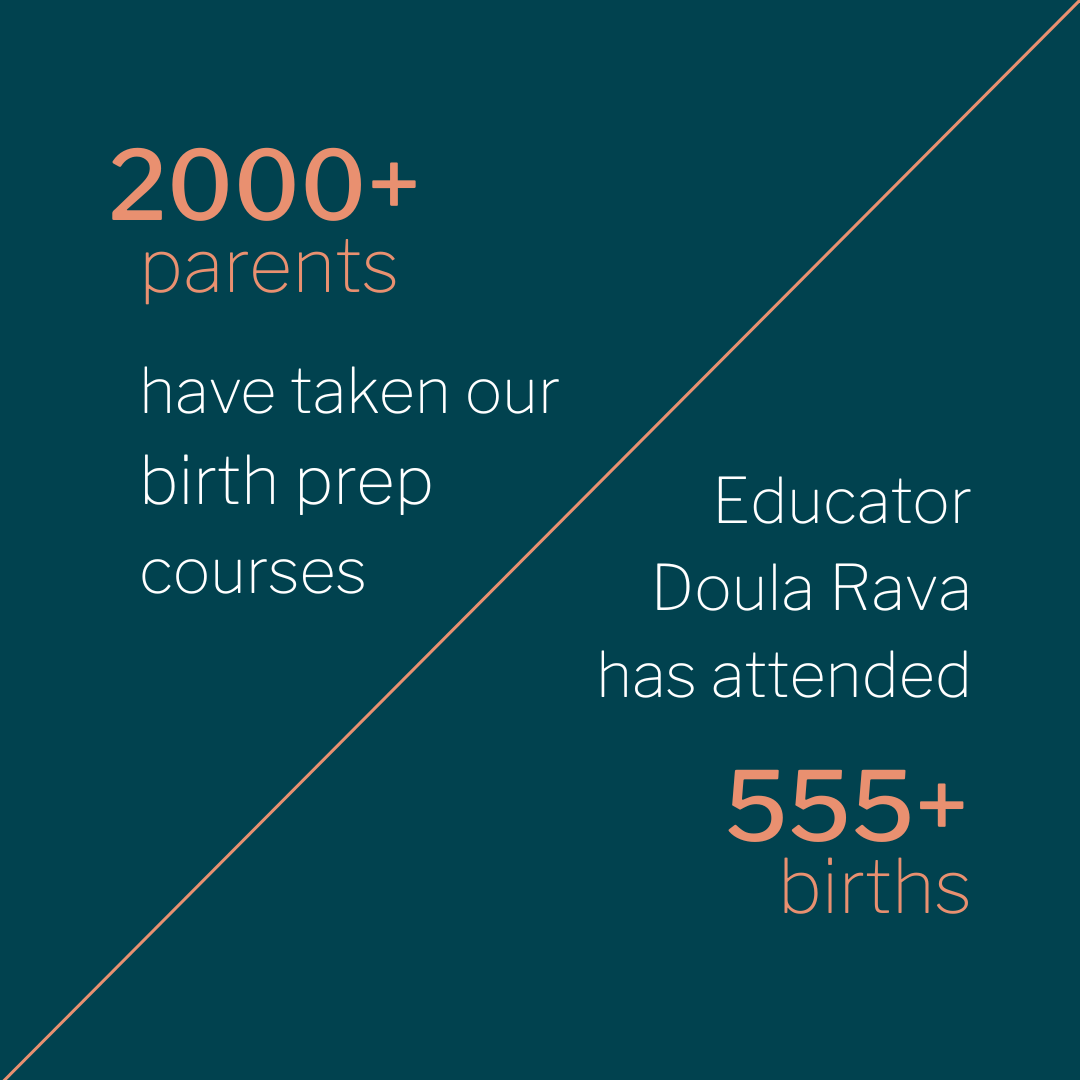Rava Womb Birth Prep Course
Rava Womb's signature self-paced 100% online course that you take from the comfort of your home!
Enjoy the freedom of learning at your own pace and when it's convenient for your schedules.
The knowledge, tools, practices and guidance are delivered in 5 ways:
1. Video: Rava teaching with incredible slides, images, video and illustrations (not a lot of birth videos and if you don't feel ready to see any video of birth yet, just skip ahead)
2. Audio: some lessons are delivered via audio, but the majority of them are video. All of the hypnosis and meditation training for your mind is delivered via audio
3. Some written material to read and helpful worksheets you can download
4. For the birth partners supporting: this course is packed with multiple cheat sheets for you!
5. This course is anchored in research and evidence-based practices in childbirth. Therefore you'll find many links to additional information if you want to read more; and links to recommended birth videos.
How do you access the course?
Access is granted to the RavaWomb learning portal - we give you a username and password. There you will find all your modules and lessons.
And you have the choice of accessing the Rava Womb portal from your browser or in our app.
What's included?
There are 13 modules. Keep scrolling to see what the modules are, and for links to the curriculum and a deeper description of each.
Enroll Now
The Modules

The Path of Labor
From your very first steps onto the path of this journey, you'll move forward with knowledge and confidence within you.
What actually happens in the body in childbirth? What can you expect? We connect the dots for you until it all makes sense, so you won't anticipate any part of this with fear. Because fear is the enemy of
birth physiology.
Learn how baby moves through your pelvis, following nature's perfect design of a sequence of movements —all so that you can work with this process to best support it to happen quicker, and more easily.
We talk about cervical checks, explore the Pelvic Clock, and see why fetal position matters for a smoother birth experience. Discover practical tools and techniques that support optimal positioning of baby —for both the end of your pregnancy and for when
you're in labor.
Learn the signposts that will show up along the way. These are emotional and behavioral signs and they're the indicators to know where you are in the journey. Partners particularly appreciate having this info, so they don't feel as much in the dark.

Positions for Labor and Birth
Your body already knows how to give birth — movement is its language. This module explores the most supportive positions for every stage of labor, helping you work with gravity, alignment and instinct to ease intensity and support progress.
At the end of these lessons you will know about dozens of positions that serve many purposes in labor: to bring more comfort, to bring baby down, to facilitate changes in baby's position, for pain relief, and for rest when you need it.
You’ll discover how positioning can make birth more efficient, less painful and deeply connected to your body’s natural wisdom.
You'll learn how to effectively put to use what is around you in your birth space: whether it's what is in your home, or how to use the mysterious birthing bed and other parts of the birthing suite at the hospital
or birth center.

Maps of the Birth Journey
Navigate the path to birth with clarity and confidence. Discover what physiologic undisturbed birth really is and how your body is designed to bring your baby into the world.
You'll learn Pregnancy and Birth Anatomy, exploring your ligaments, muscles, and learning how they impact pregnancy comfort, movement, and readiness for labor.
Gain a clear understanding of the hospital landscape: doctors, midwives, and hospital policies, so you and your partner can confidently advocate for what you want.

Water Wisdom
How to labor using water
How to have a waterbirth
Water has the power to transform your birth experience.
In this module, you’ll discover pro tips (that may not come in your birth pool package) including practical details like how and when to set up your birth pool, and what to do in advance. Hear the pros and cons for both a tub birth and a birthing pool birth. Or for using hydrotherapy for pain relief when planning
a "land birth".
You'll learn the differences that buoyancy can make in labor. One benefit it brings is being able to move your body more freely, yet you may be unsure of what waterbirth positions that are best for which parts of labor.
Learn all your options for positioning your body in the tub, shower and birth pool; and how to make use of props and tools too! Instead of reading about it in a book or online, join us and see photos and videos to demonstrating all 15+ positions.

Induction / Augmentation
of Labor
Sometimes that due date (more like guess date) comes and goes and your OB or midwife start talking about induction and you feel it looming on the horizon. Talk about pressure!
If it comes to that, what will that mean for your body, your baby, and your choices? In this module, you’ll learn what induction and augmentation actually involve and how they can affect the natural physiology of labor. We also address how to stay in control of your experience if you're induced (or if you choose augmentation after your labor started spontaneously) and how these options may affect your coping choices.
You’ll leave understanding the full picture — because we know you want all of your decisions to be made from
knowledge, not pressure.

Family Centered
Cesarean Birth
A cesarean birth can be either unexpected in the midst of labor, or scheduled. Either way, knowing your options leads to the experience being empowering.
This module guides you through how to create a calm, family-centered environment — even in the operating room.
Learn how to involve your partner, honor your baby’s first moments, and advocate for small but powerful choices that make this birth a good experience for everyone.
And learn the most important points for recovery and the early post-partum period.
You've Got Payment Options
$166
over 3 payments
MOST POPULAR
$222
over 2 payments
GET THE BONUSES
BONUSES - VALUE: $855
• Live Q & A + 1 : 1 Coaching Session with Rava Burke
(value: $150)
• Lifetime Membership in the Rava Womb parents group
(value: $500)
• Recorded Birthing Affirmations: listen to them over and over
in your pregnancy and be soothed by Rava's calming voice
(value: $75)
• Extra Cheat Sheets for Supporting Partner
(value: $65)
• Guides for pregnancy, birth & postpartum
(value: $65)
• Guidance for Communication
Value: priceless. Time to level up. It's so essential to have amazing communication skills with your partner to keep your relationship on track after baby arrives!

Pharmacological Pain Management
Options for Childbirth
Every birth is unique, and pain management is a deeply personal choice. This module helps you understand the full range of medical options so you can make informed decisions without fear or confusion.
You’ll gain clarity on the effects of each option: on you, your mindset, your labor, your mobility and your baby. And you'll learn pro tips on how to possibly minimize some
effects you'd rather avoid.
Armed with all this research-based information, you'll feel empowered to
choose what aligns with
your needs and values.

The Golden Hour
The one to two hours immediately following your baby's birth contain once-in-a-lifetime moments of connection, and opportunity.
Join us to understand why this time is vital for both baby and parents. And what ideally should happen - and not happen - during
this precious time.
You’ll learn how to effectively protect this sacred time so you're giving your baby the gentle beginning they deserve.

Mindset for Birth
Birth is a physical event, and a physiologic process, yes. But also - much like running a marathon - it is equally a mental journey of endurance, focus, and surrender.
How do you prepare to surrender though?
Is that even possible? Yes, it is
Train to gain
the mindset and skills
that will truly help you when you're in labor
—even if you plan to have an epidural. Because mindset is everything for every kind of birth: unmedicated or not, vaginal or cesarean birth.

Coping Methods for the Childbirth Year
Coping methods for your Pregnancy, Labor and early Postpartum
This in-depth module gives you numerous coping methods you can use not only in labor, but also to manage pregnancy discomfort (those moments give you the opportunity to practice these methods), as well as for coping with the challenges of the early weeks and months with a newborn.
These are the non-drug methods; the pharmacological options are covered in another module. Now what if you're thinking you might get an epidural? Well, there's definitely an early phase of labor that you need to get through until the timing is right for an epidural. And these are the techniques you need to learn so you can cope during this early labor phase (and all phases, even if you do have an epidural, even if you do have a cesarean birth!)
Techniques and practices that aren't just for labor! So that means you can use them now in your pregnancy for any discomfort or stress you might be experiencing. You can also use them in your postpartum period. Many RavaWomb clients write in reviews about how they've used them for the rest of their lives - they are that valuable.
An essential part of any coping method to be effective is knowing what is happening inside one's body as it labors. So we cover what happens in labor and how labor progresses. And for partners we teach what are the best coping practices to match with what labor moments.

Birth Partner Training
Being a great support to your partner isn’t about being like a doula or being perfect. It’s about being fully present and knowing about words and tone that help, and having some amazing techniques and skills ready to go. Even if you have to look at the cheat sheets we give you to remember them!
This module shows birth partners how to offer calm, grounded, and intuitive support through every stage of labor. You’ll learn what to say, when to step in, and when to simply hold space, so your supportive role is a source of strength, safety, and connection.
-
Partners: learn how to manually use specific techniques in certain areas (using your hands, legs, tools etc.). What these techniques are, and how to do them correctly and effectively. These aren't massage techniques - massage is what is called a "comfort measure". These techniques are the beast!
-
These techniques reduce labor sensations and pain she is experiencing by as much as 50% and when combined with other practices, the discomfort, pain, intensity can be reduced even more. All by you knowing what to do and how to do it - good news right? Be a rockstar in the birthspace!
-
When to call, who to call, when to leave for your birthing place (if not birthing at home); how to time uterine contractions (it's not what you might think). The best apps for this (some are crap) and what settings you want on the app. And much more about this crucial part of your role.
-
Learn the common pitfalls to avoid when supporting your partner in labor (it's not what you might think).
-
Learn what tools and "stuff" that you need most for the labor —and how to use these tools.
-
Learn what items you do not need. This is especially important when birthing at hospital or birth center - so you don't end up bringing in four suitcases. Not very practical. And not necessary.

Options for Monitoring Your Baby's
Heart Rate in Labor
Did you know that monitoring your baby's heart rate when you are in labor is one of the most important & primary ways that your midwife or doctor monitors the well-being of your baby?
Did you know that there a few ways this can be done, and that you do have options to choose from?
You may have a preference and you could include this in your birth plan. It's good to be educated about when a certain option might be more ideal than another. Learn all the consequences of each choice.

Guided Meditation and Hypnosis for Childbirth
Calm your nerves, alleviate stress and regulate your
nervous system right now during your pregnancy and
when you are in labor.
Are you thrilled about your baby, but have fears, concerns and questions about birth, parenting or postpartum?
Going in blindly, and just hoping for the best, almost always results in suffering, struggle and often even birth trauma. Join us to gain the knowledge, confidence and advocacy skills you'll need for an empowered birth!

You'll be ready. We promise.
You just need support to get there.
Learn from one of the most experienced Canadian doulas and childbirth educators Rava Burke
Want to know more about her? >> Rava

Guided Meditation and Hypnosis for Childbirth

Coping in the Childbirth Year
Coping methods for your Pregnancy,
Labor and early Postpartum
Are you afraid of labor pain?
Uncertain about what childbirth really feels like?
Anxious that it might be the most pain you've ever experienced?
Of course you're believing that—it's what western culture has conditioned us to think. That birth is the worst pain in the world.
When birth happens in movies and tv shows that's the script —because drama sells. If birth were portrayed realistically, intense but manageable, it would be boring television!
Here's the truth: it's not the worst pain a human can feel. Women who have experienced both childbirth and kidney stones consistently report that kidney stones were far more painful than giving birth.
Do you sometimes think you just don't know how you'll cope with labor without an epidural?
You've likely heard that epidurals can be helpful, and many women have shared positive experiences. But you might be surprised to learn that timing matters! Because proper timing can prevent negative consequences.
Getting the timing right is an ideal approach if getting an epidural: so that it doesn't affect your labor.
Don't believe that 100% of the time getting an epidural leads to the need for Pitocin (the artificial hormone used to keep contractions going). Or that it always leads to cesarean. The truth is Pitocin and Cesarean do become statistically more likely when an epidural is part of birth.
What isn't talked about though is this good news: you can reduce your chances of needing a c-section or having your labor augmented by managing many factors in epidural use. In Rava Womb Birth Prep you learn exactly how to do this.
Are you worried about getting to the hospital too soon? Arriving at Labor and Delivery and told you're there "too early" and being sent home?
Or maybe you've heard the longer you are there the more interventions they'll want to do (sadly, this is true).
It is true that they don't accept mothers into the L & D unit until you're at a certain stage in labor. For most hospitals this is when a woman's cervix is open to 6 cm (for 1st baby). There's a new saying these days: "6 is the new 4". Because it used to be - even with your 1st labor - you'd be admitted at 4 cm. Now it's 6 cm. For 2nd and subsequent babies it's 4 cm.
So if an epidural is part of your coping plan, just know you cannot get one at 1 cm dilation. And you wouldn't want to!! Because having an epidural that early has very negative consequences on how your labor will unfold. In the shortest phrase possible: "epidurals really mess with labor!" But these effects can be mitigated.
These hospital policies mean getting an epidural early in labor is not an option so this means thinking about how to cope up until then. Rava Womb Birth Prep teaches you so many coping practices so that you will be able to cope (up to 6cm—1st labor; up to 4 cm—2nd+ labors).
If you are having any of those thoughts, then it's likely you don't yet have what you need to give birth to your baby without fear.
And these thoughts aren't unique to you. Many (most) expectant mothers have these thoughts.
In our Western culture we've been taught to fear the pain of childbirth and told that birth is terrible! The worst pain a human can feel!
It's no wonder you might be having these thoughts!
Limited time offer of
$725
value
$725
$417
Get your Birth Prep Course now
It's never too early - anytime after 20 weeks is a good time to start
© RavaWomb 2024

